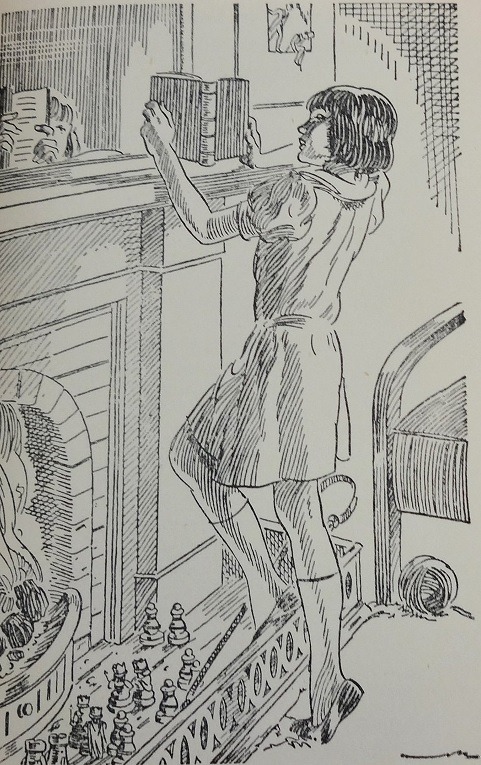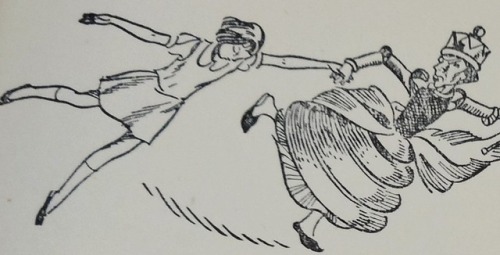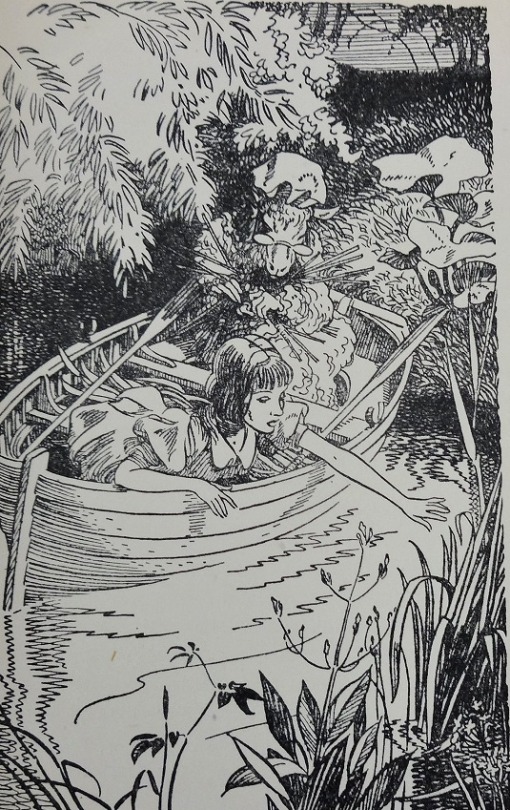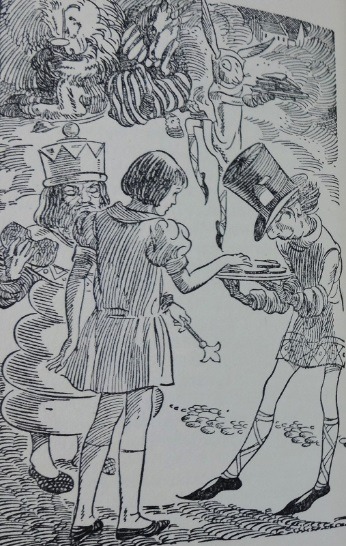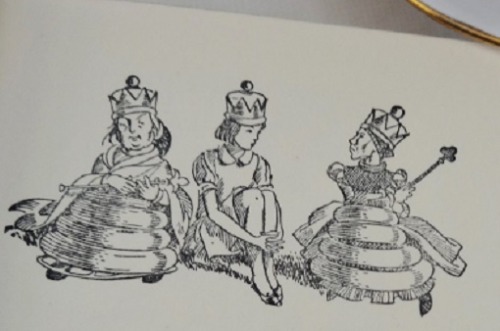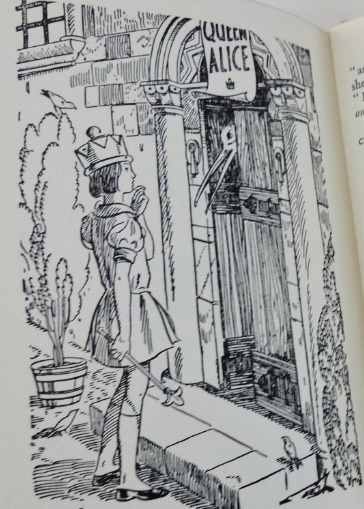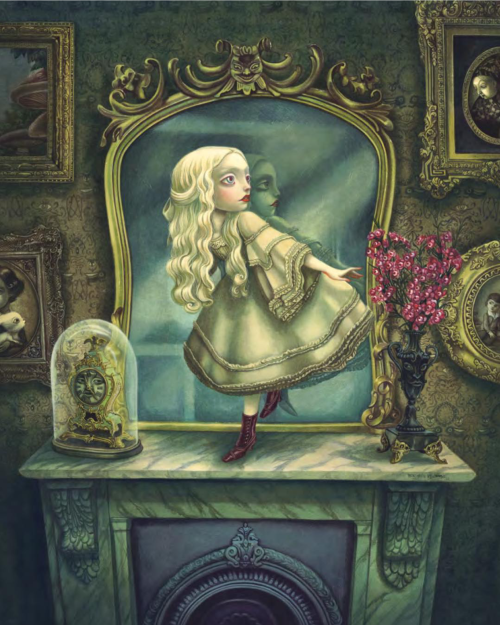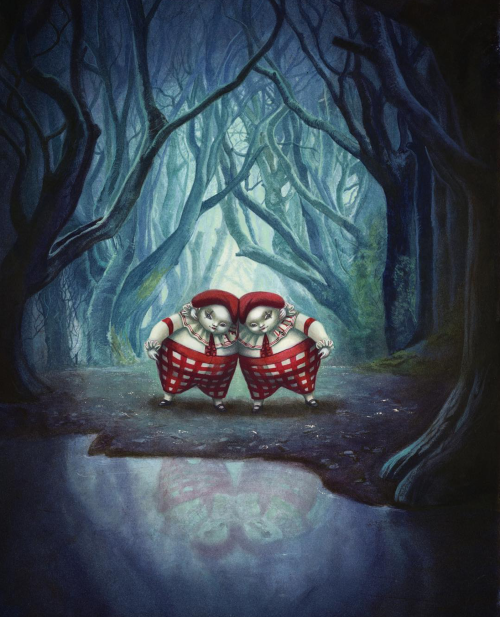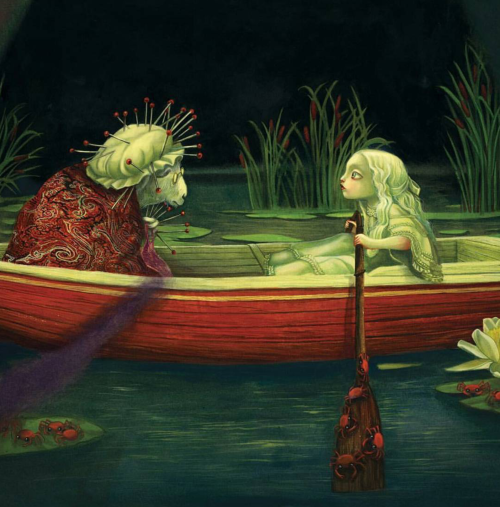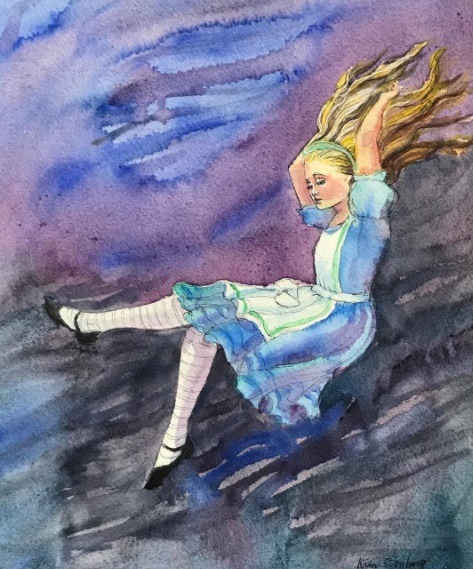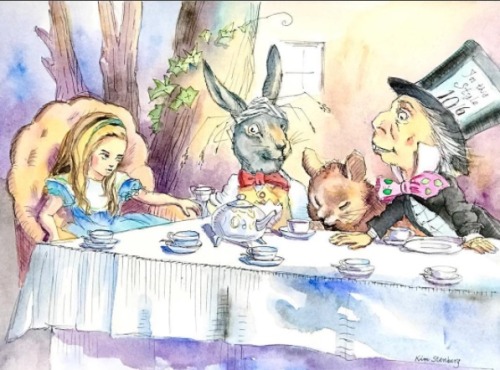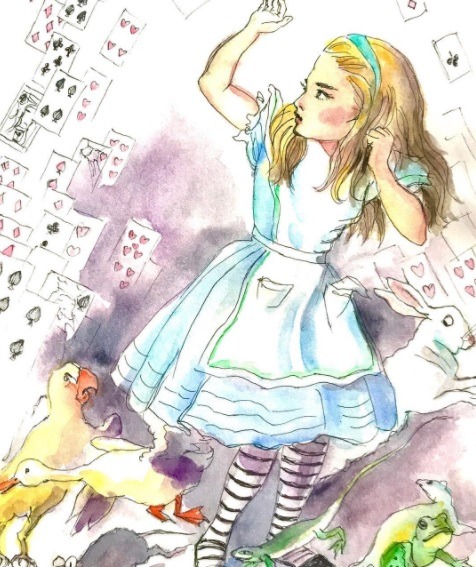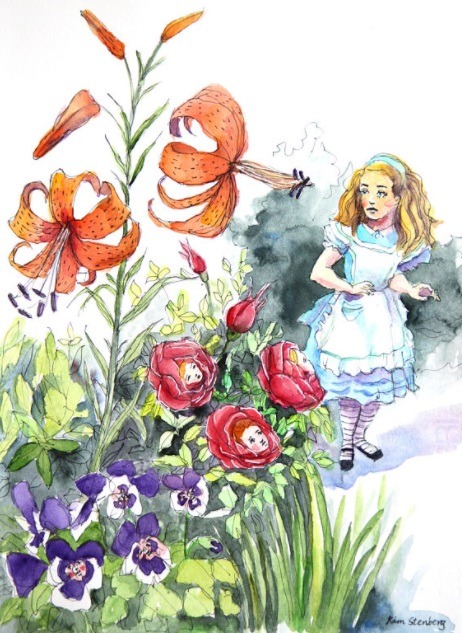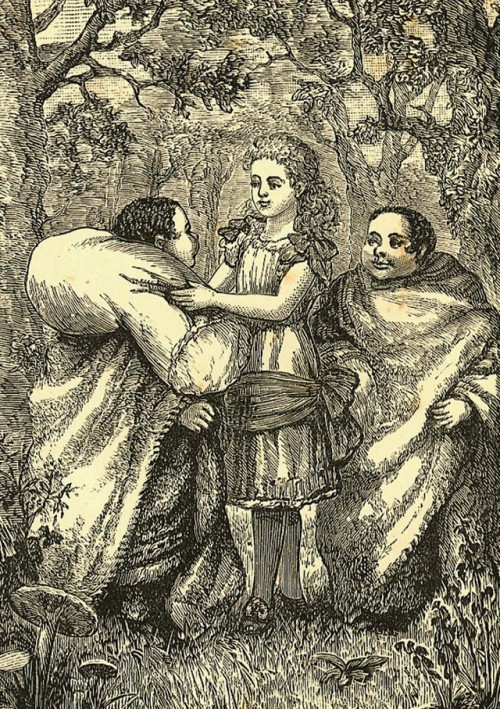
Alice, Dum and Dee in an illustration for a 1883 stage version of Through the Looking-Glass. I can find no other record of the actual stage production sadly, or the illustrator's name.
This lovely illustration reminds me of Victorian wood block illustrations.
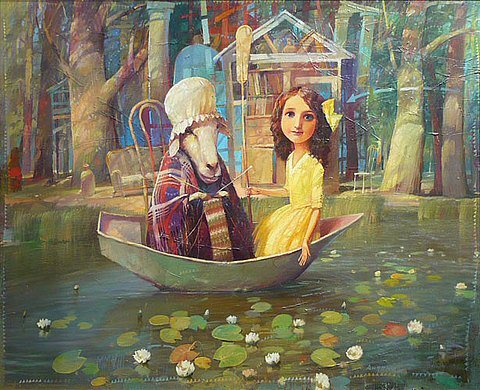
`Can you row?’ the Sheep asked, handing her a pair of knitting-needles as she spoke. `Yes, a little – but not on land – and not with needles – ’ Alice was beginning to say, when suddenly the needles turned into oars in her hands, and she found they were in a little boat, gliding along between banks: so there was nothing for it but to do her best.
Illustration by Alexander Antoniuk for Carroll's Through the Looking-Glass
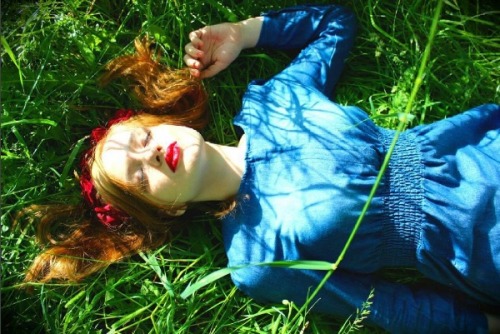
- and found herself lying on the bank, with her head in the lap of her sister, who was gently brushing away some dead leaves that had fluttered down from the trees upon her face. “Wake up, Alice dear!’ said her sister; `Why, what a long sleep you’ve had!‘
Photo by nastik_love_shk for Carroll’s Alice’s adventures in Wonderland
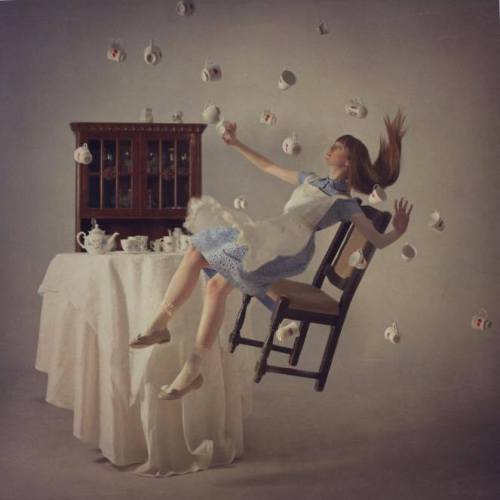 Photography based on Carroll's Alice's adventures in Wonderland by Anka Zhuravleva
Photography based on Carroll's Alice's adventures in Wonderland by Anka Zhuravleva

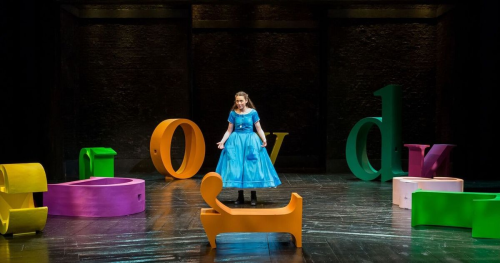 (Rabecca Birch as Alice in the World Premiere 2017 cast at Chester’s StoryHouse Theatre. Photo: Mark Carline)
(Rabecca Birch as Alice in the World Premiere 2017 cast at Chester’s StoryHouse Theatre. Photo: Mark Carline)
This mash up of parts of both Alice tales was commissioned by the new multi million pound theatre in Chester, UK. Staged in 2017, it opened to extremely enthusiastic reviews, meeting with the same acclaim that Glyn Maxwell’s other adaptations of classic literature have also gained.
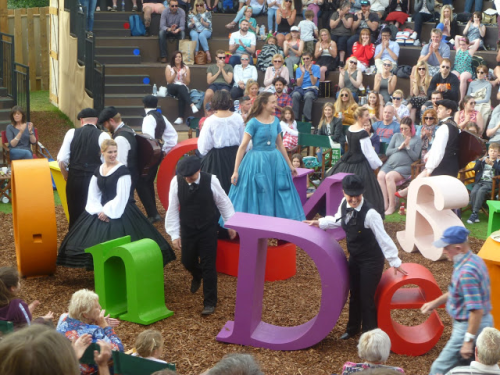 That being said, this isn’t the most easiest adaptation in the world to review. Because on first time reading, I did not have a clue what to make of it. To be clear, Maxwell’s adaptations all fall somewhere between adaptation and re-imagining, and this is no exception.
That being said, this isn’t the most easiest adaptation in the world to review. Because on first time reading, I did not have a clue what to make of it. To be clear, Maxwell’s adaptations all fall somewhere between adaptation and re-imagining, and this is no exception.
Maxwell’s overarching subplot of this version is that frightened of going to boarding school, Victorian Alicia splits herself into 2. Alice goes off to boarding school (which of course also turns out to be Wonderland) whilst Alicia stays in the real world, and grows ill. Very, very ill.
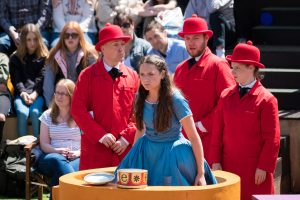 Act 1 has Alice stumbling round a Wonderland as boarding school setting, with everyone being immensely unhelpful. She ends the act so confused she turns into the Red Queen (by that, I mean the Queen of Hearts). But I couldn’t help noticing that in adaptation terms this was very, very fast paced and short.
Act 1 has Alice stumbling round a Wonderland as boarding school setting, with everyone being immensely unhelpful. She ends the act so confused she turns into the Red Queen (by that, I mean the Queen of Hearts). But I couldn’t help noticing that in adaptation terms this was very, very fast paced and short.
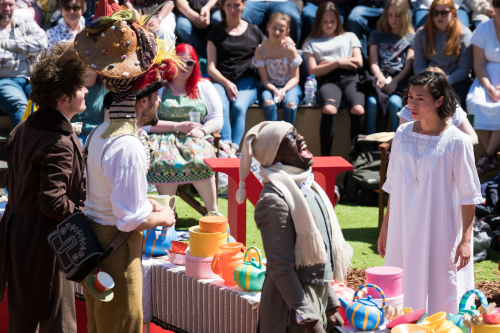 That’s because in act 2 bed-ridden Alicia tries to search for Alice via her illness induced fever dreams (yes, really!) and encounters more Wonderland/Looking-Glass residents. Particularly funny are the intensely Scottish Unicorn (of Through the Looking-Glass) and the Cheshire Cat, who fades away before he can offer Alicia any good advice. There’s also the fantastic addition of Alicia pointing out to everyone she comes across that they aren’t real.
That’s because in act 2 bed-ridden Alicia tries to search for Alice via her illness induced fever dreams (yes, really!) and encounters more Wonderland/Looking-Glass residents. Particularly funny are the intensely Scottish Unicorn (of Through the Looking-Glass) and the Cheshire Cat, who fades away before he can offer Alicia any good advice. There’s also the fantastic addition of Alicia pointing out to everyone she comes across that they aren’t real.
On finding Alice, Alicia finds her raving and braying for beheadings. Turns out, she’s playing at being the Red Queen (The Queen of Hearts) because she’s lonely and everyone she’s met in Wonderland seems to despise her. Alicia convinces her to drop the act before they both face off against Alice’s greatest fear- The Jabberwock.
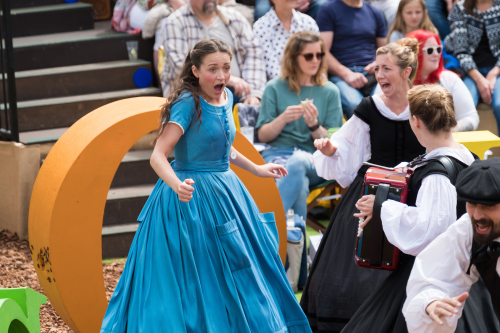 If me describing this version made no sense, reading the actual script multiplies that feeling. Maxwell seems to put parts of both Alice tales into a food blender, making his adaptation feel almost entirely like the 113 degree fever that Alicia is suffering from.
If me describing this version made no sense, reading the actual script multiplies that feeling. Maxwell seems to put parts of both Alice tales into a food blender, making his adaptation feel almost entirely like the 113 degree fever that Alicia is suffering from.
In a way, its curious that no one has ever adapted carroll’s tales as fever dreams before- because that concept works very very well in this version. Almost too well…
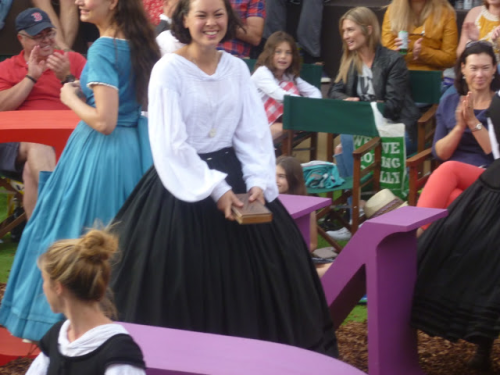 I also love the idea of having 2 split Alices. One in the real world, one in Wonderland. In a way, you can feel the influence of Moira Buffini’s National Theatre flop Wonder.land on this version (compare Aly and avatar Alice’s friendship with Alicia and Alice’s. Its very similar!) which is no bad thing!
I also love the idea of having 2 split Alices. One in the real world, one in Wonderland. In a way, you can feel the influence of Moira Buffini’s National Theatre flop Wonder.land on this version (compare Aly and avatar Alice’s friendship with Alicia and Alice’s. Its very similar!) which is no bad thing!
I honestly hope this gets more productions in the future. It was fascinating.
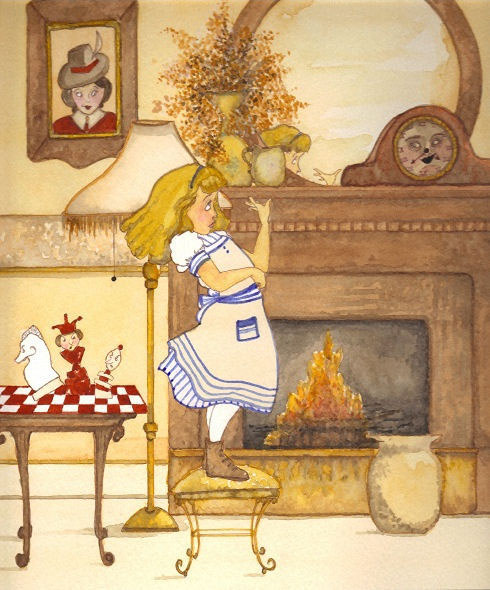 Illustration for Carroll's Through the Looking-Glass by Mary Manning
Illustration for Carroll's Through the Looking-Glass by Mary Manning
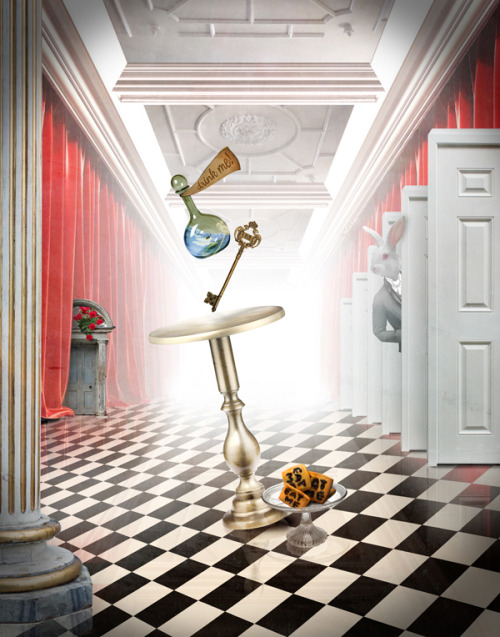
Alice had got so much into the way of expecting nothing but out-of-the-way things to happen, that it seemed quite dull and stupid for life to go on in the common way.
This lovely piece of photoart is by Alena Arsenteva, for Carroll's Alice's adventures in Wonderland. She’s done quite a few Alice illustrations but this is my personal fave by her.
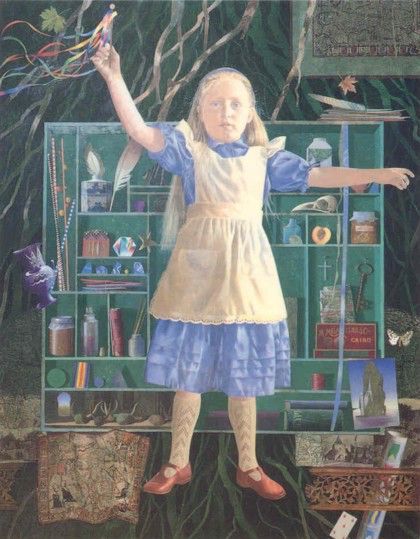
The shop seemed to be full of all manner of curious things – but the oddest part of it all was, that whenever she looked hard at any shelf, to make out exactly what it had on it, that particular shelf was always quite empty: though the others round it were crowded as full as they could hold. `Things flow about so here!’ she said at last in a plaintive tone.
The Dream Child by Arnold Graham for Carroll's Through the Looking-Glass
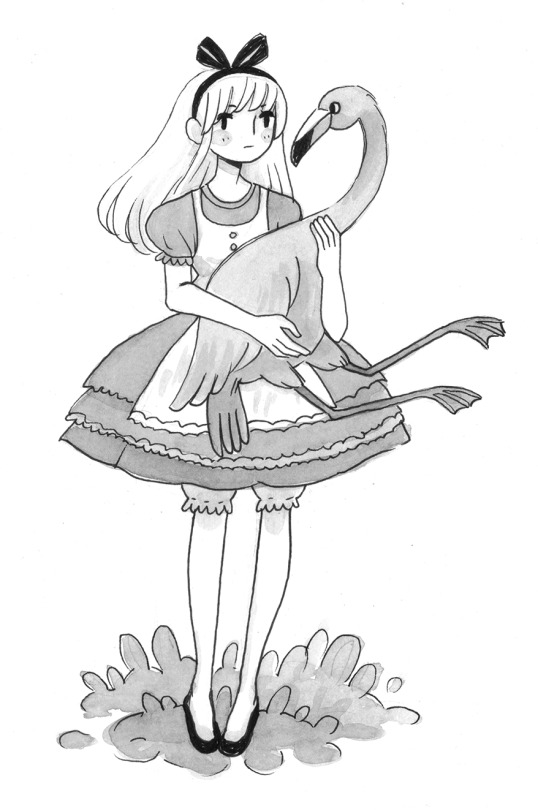 Alice and flamingo by heikala for Carroll's Alice's adventures in Wonderland
Alice and flamingo by heikala for Carroll's Alice's adventures in Wonderland
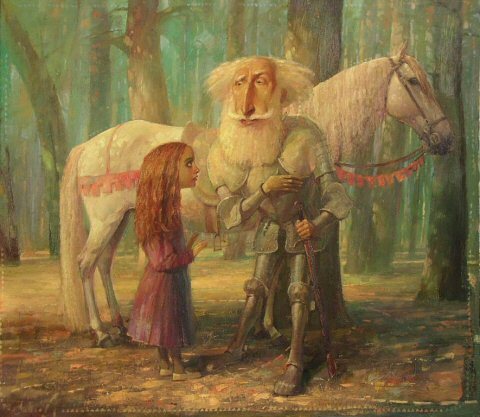 Alice and the White Knight by Alexander Antoniuk for Carroll's Through the Looking-Glass
Alice and the White Knight by Alexander Antoniuk for Carroll's Through the Looking-Glass
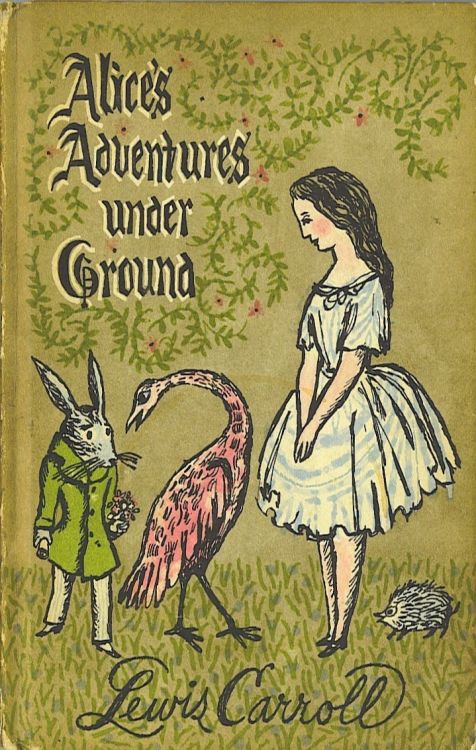 a Lovely cover for Alice’s adventures Underground, the Manuscript for the book which would become Alice’s adventures in Wonderland. Illustrations based on Lewis Carroll’s, unknown illustrator.
a Lovely cover for Alice’s adventures Underground, the Manuscript for the book which would become Alice’s adventures in Wonderland. Illustrations based on Lewis Carroll’s, unknown illustrator.
Source: Pinterest
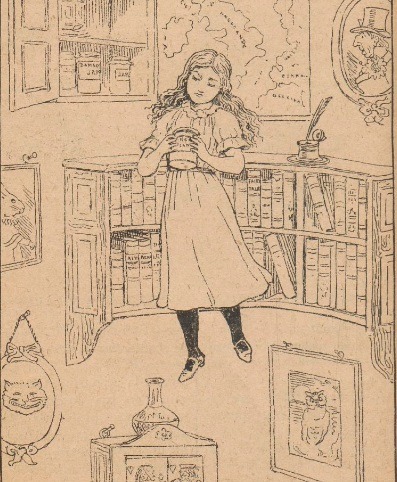 by an unknown French illustrator for Carroll’s Alice’s adventures in Wonderland, this is from a 1910 text which uses Bernard-Henri ‘s translation.
by an unknown French illustrator for Carroll’s Alice’s adventures in Wonderland, this is from a 1910 text which uses Bernard-Henri ‘s translation.
Source is from a French library archive. Any more info would be appreciated!
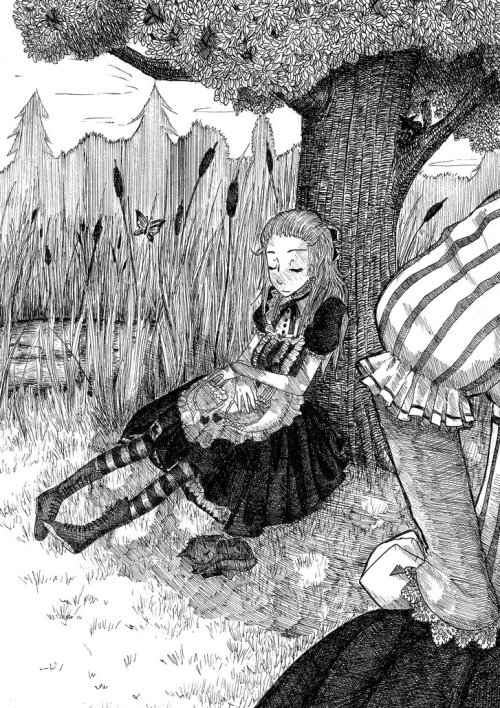 Alice dreaming of Wonderland, illsutration by by shokoholic for Carroll's Alice's adventures in Wonderland
Alice dreaming of Wonderland, illsutration by by shokoholic for Carroll's Alice's adventures in Wonderland
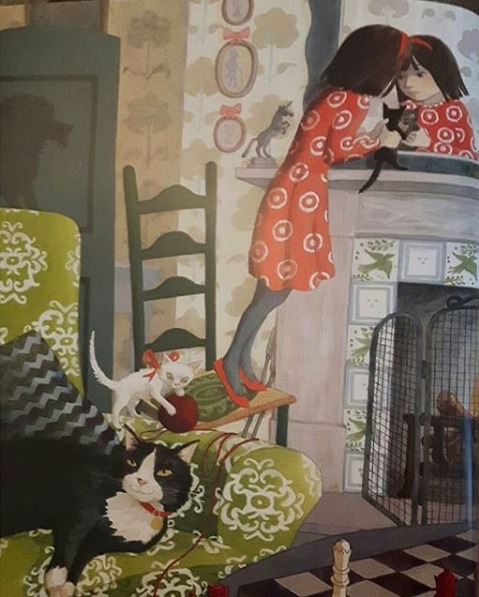 Alice investigates the Looking-Glass, illustration by Emma Chichester Clark for Carroll’s Through the Looking-Glass
Alice investigates the Looking-Glass, illustration by Emma Chichester Clark for Carroll’s Through the Looking-Glass
This illustration is via the wonderful instagram wonderland_illustrated, which has an amazing selection of illustrations from both Alice novels and is updated frequently.
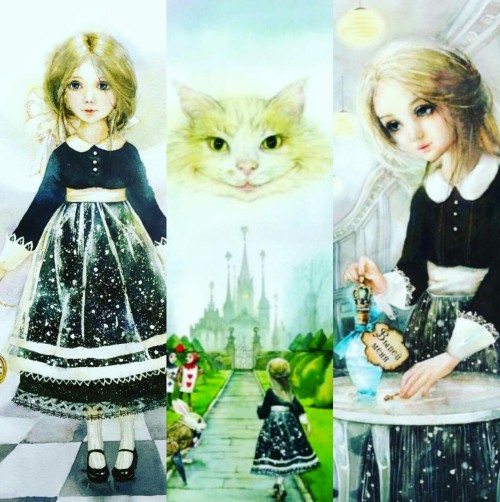
Alice’s adventures in Wonderland illustrated by Christonia Eugina.
This as well as Looking Glass are now published and I have no excuse not to have a copy. These are so beautiful!
How could I not save this photo from tumblr?
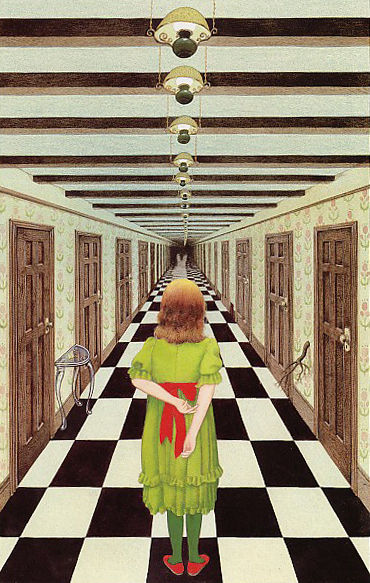
Alice in the hall of doors by Anthony Browne for Carroll's Alice's adventures in Wonderland
This is my personal favourite out of Browne's illustration set.
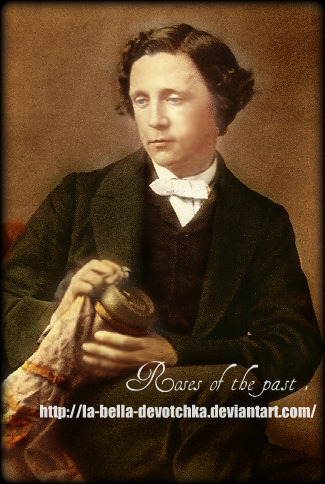
Colourised photo of Lewis Carroll, edit by La-Bella-Devotchka
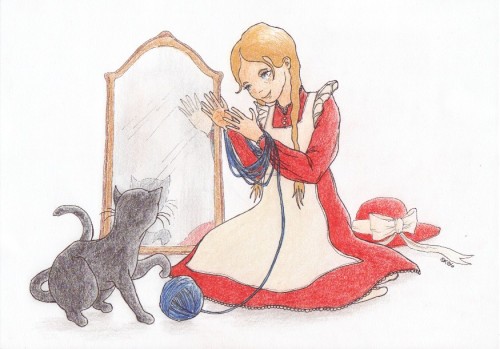
chainedtothemirror’s illustration for Carroll’s Through the Looking-Glass
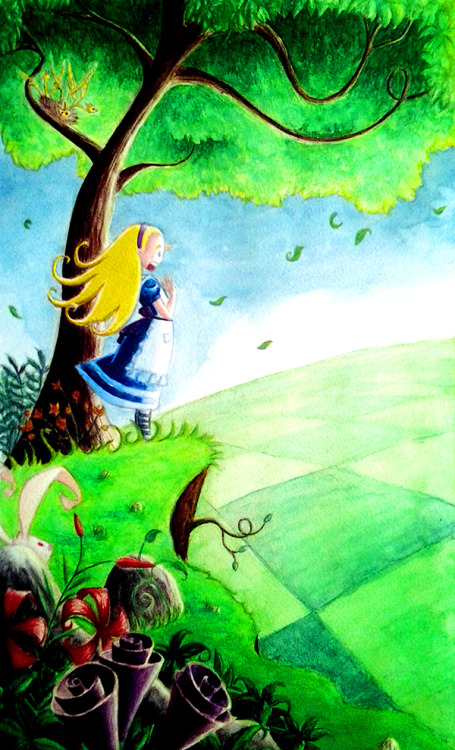 Alice surveys the Looking-Glass World in an illustration by Diego Henrique G for Carroll’s Through the Looking-Glass.
Alice surveys the Looking-Glass World in an illustration by Diego Henrique G for Carroll’s Through the Looking-Glass.

Drink Me by Hugh Gee for Carroll's Alice's adventures in Wonderland.
Fun fact: As a kid I thought this was a film still due to how photo like it is! To this day it remains one of my most favourite illustrations.
Going to be saving my fave carrollian photos/illustrations to this blog in the next few weeks!
Sadly can't save everything but I will choose the loveliest archive illustration posts I have!
Many thanks,
Chloe :)
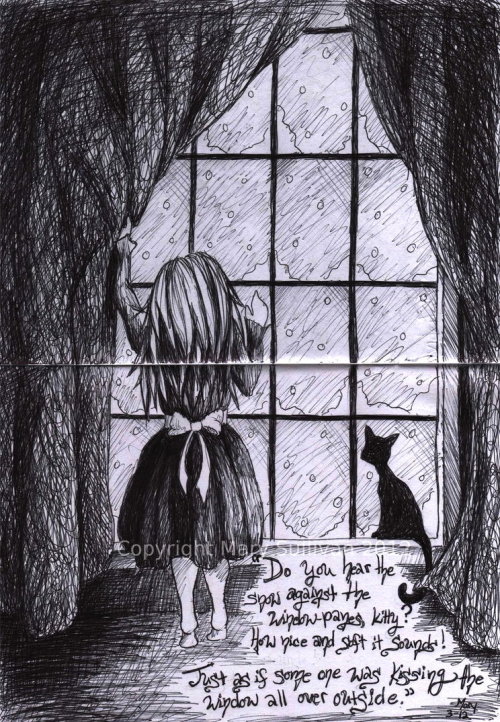 Alice and Snowflakes by marykyart for Carroll’s Through the Looking-Glass
Alice and Snowflakes by marykyart for Carroll’s Through the Looking-Glass
“Do you hear the snow against the window-panes, Kitty? How nice and soft it sounds! Just as if some one was kissing the window all over outside.
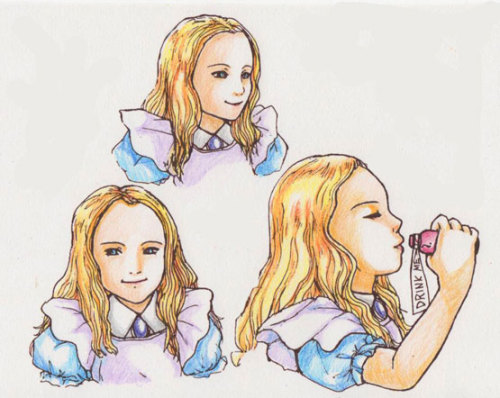
round the neck of the bottle was a paper label, with the words `DRINK ME’ beautifully printed on it in large letters.
“Drink Me” illustration for Carroll’s Alice’s adventures in Wonderland by Minkirura
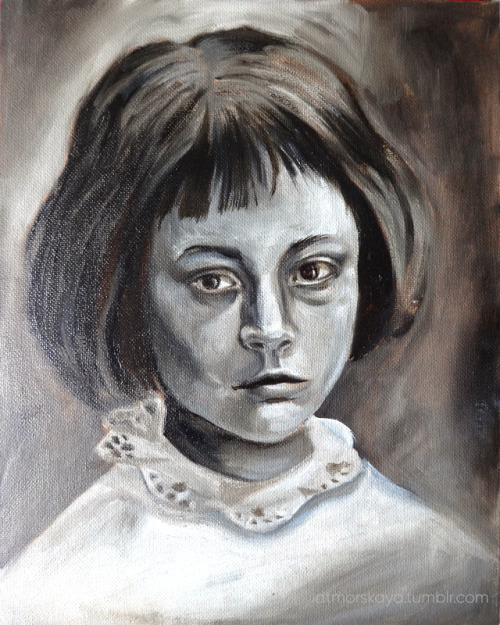 Alice Liddell by Atmorskaya
Alice Liddell by Atmorskaya

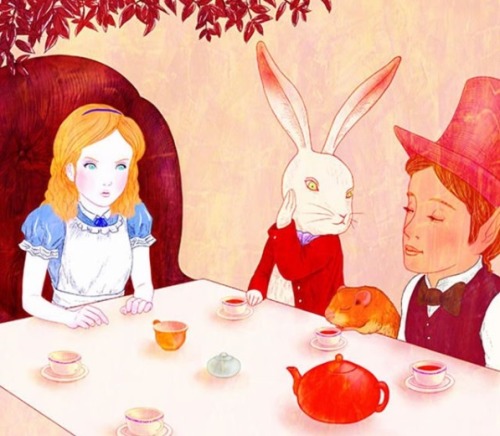 Sai Tamiya’s illustrations for Carroll’s Alice’s adventures in Wonderland
Sai Tamiya’s illustrations for Carroll’s Alice’s adventures in Wonderland
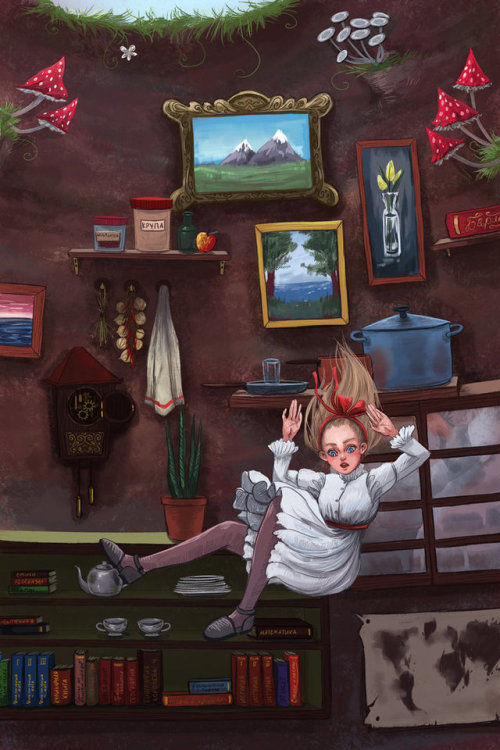
Either the well was very deep, or she fell very slowly, for she had plenty of time as she went down to look about her and to wonder what was going to happen next.
Down the Rabbit hole (For Carroll’s Alice’s adventures in Wonderland) by fcnjt
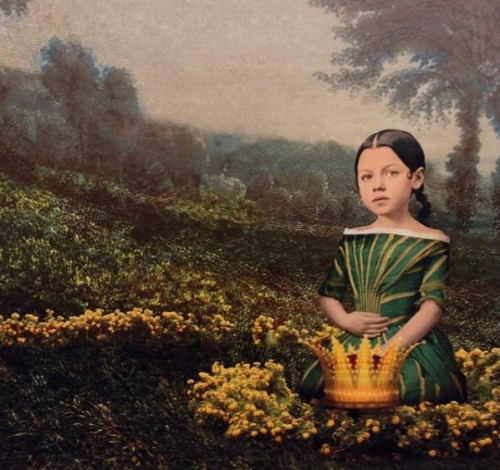
`To the Looking-Glass world it was Alice that said,“I’ve a sceptre in hand, I’ve a crown on my head;Let the Looking-Glass creatures, whatever they be,Come and dine with the Red Queen, the White Queen, and me.”’
Maggie Taylor for Carroll’s Through the Looking-Glass
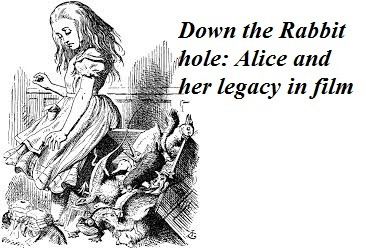
ARCHIVAL NOTE: VOTING FOR THE 2019 PROJECT IS NOW OPEN!
MAJOR SPOILERS AHEAD.
ALSO, OBVIOUS EMPHASIS ON THE FANTASY PARTS OF THIS FILM, DESPITE HOW WELL MADE THE CIVIL WAR PLOTS ARE IN THIS FILM, I CAN’T REALLY TALK ABOUT THEM HERE … SORRY…
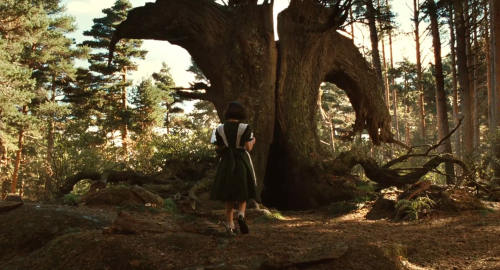 Pan’s Labyrinth is both a dark deconstruction of the down the rabbit hole trope and a warning on the corruption and disregard for humanity fascism brings. The film is one of a few examples (along with Valerie and her Week of Wonders) of how the down the rabbit hole trope can be subverted and deconstructed for an adult audience.
Pan’s Labyrinth is both a dark deconstruction of the down the rabbit hole trope and a warning on the corruption and disregard for humanity fascism brings. The film is one of a few examples (along with Valerie and her Week of Wonders) of how the down the rabbit hole trope can be subverted and deconstructed for an adult audience.
12 year old Ofelia moves with her pregnant mother to a house inhabited by the monstrous captain Vidal, who spends his time tracking down any dissenters to the new fascist regime. Ofelia buries herself in books, and whilst exploring a stone labyrinth, encounters a faun who claims she is the lost princess of the underworld. Ofelia has three grizzly tasks to complete if she wants to leave the real world behind. All the while the situation at home only gets more fraught and horrifying.
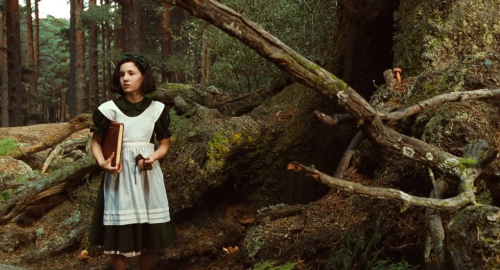 Whilst Ofelia is quickly identified as an Alice archetype by default, (the green dress and white pinafore she wears before the first task making this clear), what differentiates her from other protagonists I’ve looked at for this project is her willingness to escape. For Ofelia, living anywhere but home is desirable.
Whilst Ofelia is quickly identified as an Alice archetype by default, (the green dress and white pinafore she wears before the first task making this clear), what differentiates her from other protagonists I’ve looked at for this project is her willingness to escape. For Ofelia, living anywhere but home is desirable.
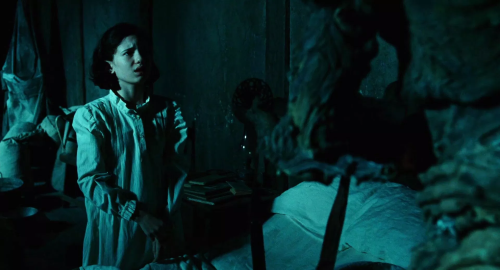 After the faun angrily comes to the conclusion that she has failed the second task due to giving into hunger for food she begs him with all her might for another chance. Most protagonists of these films and the trope codifier, Carroll’s Alice, unwittingly stumble into their lands or encounters and attempt to return home or back to some kind of normality. Ofelia meanwhile wants more than anything to leave her current circumstances behind.
After the faun angrily comes to the conclusion that she has failed the second task due to giving into hunger for food she begs him with all her might for another chance. Most protagonists of these films and the trope codifier, Carroll’s Alice, unwittingly stumble into their lands or encounters and attempt to return home or back to some kind of normality. Ofelia meanwhile wants more than anything to leave her current circumstances behind.
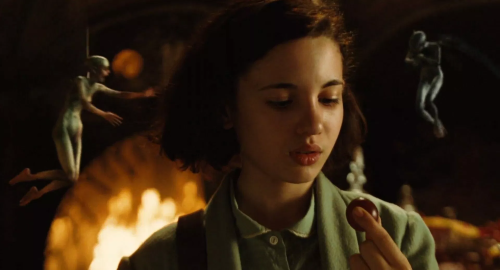 And although Ofelia does encounter animals and creatures (mainly mythological) a far darker tone is struck than a typical rabbit hole film, partly this is due to its adult audience but also due to its various plot strands regarding the brutal civil war. Ofelia’s trials have a habit of mirroring her harsh surroundings such as when Vidal starves the household, and Ofelia eats in the Pale Man’s realm, despite warnings from the faun.
And although Ofelia does encounter animals and creatures (mainly mythological) a far darker tone is struck than a typical rabbit hole film, partly this is due to its adult audience but also due to its various plot strands regarding the brutal civil war. Ofelia’s trials have a habit of mirroring her harsh surroundings such as when Vidal starves the household, and Ofelia eats in the Pale Man’s realm, despite warnings from the faun.
Unlike other films of this genre, this mirroring gives Pan's Labyrinth an almost allegorical type resonance, and there have already been several high profile essays by scholars linking the film with its historical climate.
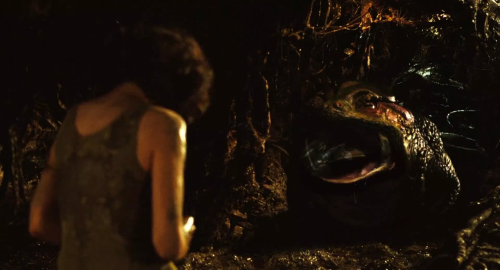 Ofelia’s decent into a tree to retrieve a key from an old toad is Alice like in text but not tone. Despite Ofelia’s assertions that she isn’t afraid, as an audience we see her vulnerability as well as bravery in this scene. The toad is the polar opposite of Carroll’s frog footman, instead of being bumbling and comedic, the amphibian Ofelia encounters is selfish, covetous and gluttonous. Ofelia gains the key by tricking the animal through offering mud as food. In a way, this scene is a similar to but offers a far darker take on the scene in Spirited Away (2002) where Chihiro gives No-Face medicine. When Ofelia crawls back out, key in hand, she finds her “Alice” dress has been forever ruined by the trees.
Ofelia’s decent into a tree to retrieve a key from an old toad is Alice like in text but not tone. Despite Ofelia’s assertions that she isn’t afraid, as an audience we see her vulnerability as well as bravery in this scene. The toad is the polar opposite of Carroll’s frog footman, instead of being bumbling and comedic, the amphibian Ofelia encounters is selfish, covetous and gluttonous. Ofelia gains the key by tricking the animal through offering mud as food. In a way, this scene is a similar to but offers a far darker take on the scene in Spirited Away (2002) where Chihiro gives No-Face medicine. When Ofelia crawls back out, key in hand, she finds her “Alice” dress has been forever ruined by the trees.
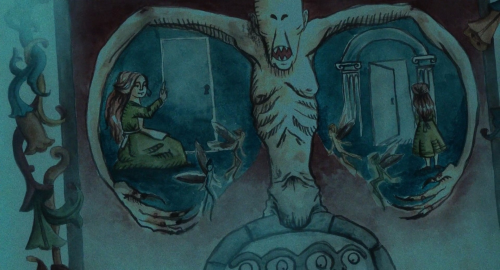 Similarly for the second task Carrollian plot points are set up then subverted. Ofelia is given a piece of chalk by the fawn and the book of crossroads, which gives her details on the pale man’s realm (the illustration again references Carroll by the use of a young girl in an apron dress drawing a door).
Similarly for the second task Carrollian plot points are set up then subverted. Ofelia is given a piece of chalk by the fawn and the book of crossroads, which gives her details on the pale man’s realm (the illustration again references Carroll by the use of a young girl in an apron dress drawing a door).
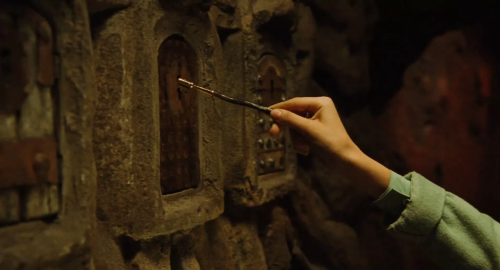 Ofelia follows the instructions and crawls through a door to the hall of the pale man’s realm, where she takes a key and has to put it in the correct lock. This situation recalls Alice’s trials in Wonderland’s hall of doors:
Ofelia follows the instructions and crawls through a door to the hall of the pale man’s realm, where she takes a key and has to put it in the correct lock. This situation recalls Alice’s trials in Wonderland’s hall of doors:
a tiny golden key, and Alice’s first thought was that it might belong to one of the doors of the hall; but, alas! either the locks were too large, or the key was too small, but at any rate it would not open any of them.
Yet Ofelia once again is in a far more perilous situation. At the other end of the hall is the child eating pale man, and the cupboard she eventually opens reveals a sharp knife, resembling illustrations of the Vorpal sword from Carroll’s poem from Through the Looking-Glass, The Jabberwocky. This is later used to try and spill the blood of an innocent in the third task.
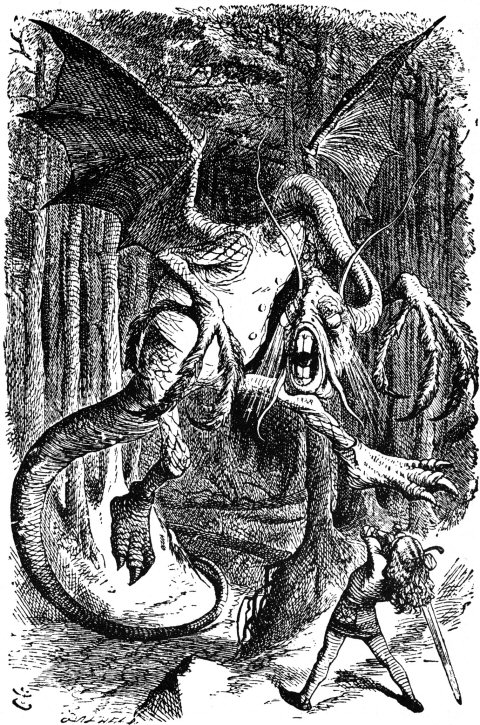
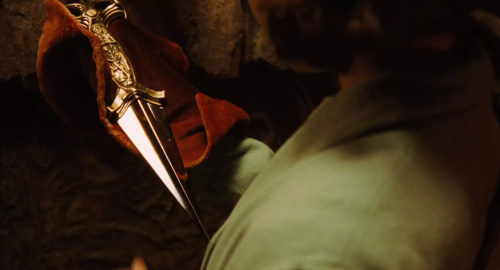 Overall Pan’s Labyrinth provides one of the finest examples of making a down the rabbit hole archetypal film for an older audience. By subverting and deconstructing the tropes audiences know, this film carves out a unique, if often dark path.
Overall Pan’s Labyrinth provides one of the finest examples of making a down the rabbit hole archetypal film for an older audience. By subverting and deconstructing the tropes audiences know, this film carves out a unique, if often dark path.
STRAY NOTES
- A musical version is apparently in development and will premiere soon.














